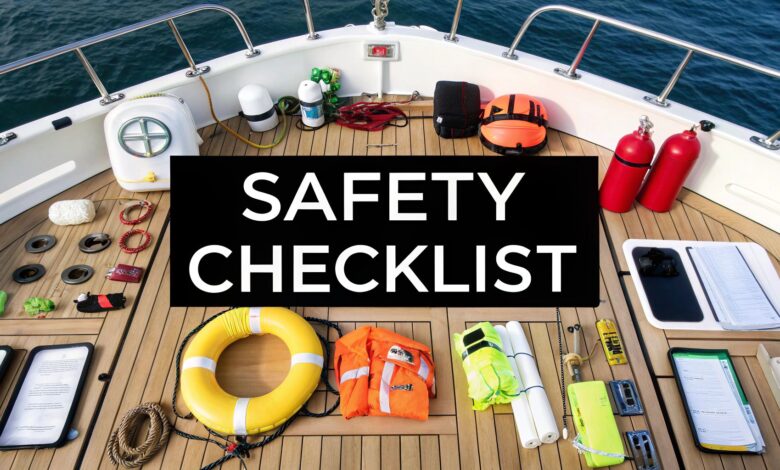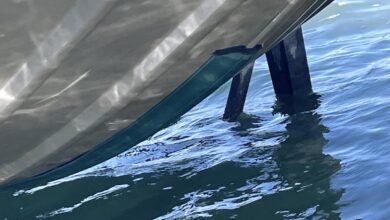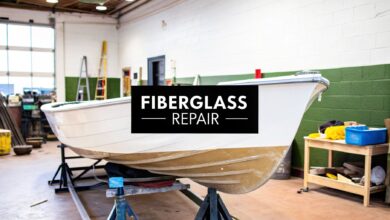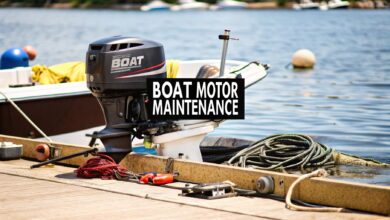
Heading out on the water brings a unique sense of freedom, but true confidence comes from thorough preparation. A comprehensive pre-departure routine is the most critical tool a captain has to prevent emergencies. This ensures a smooth, enjoyable trip for everyone aboard.
This guide provides an in-depth boating safety checklist, breaking down eight essential areas that demand your attention. From vital communication checks to crew briefings, each step is designed to be actionable and clear. We will cover everything from filing a float plan to inspecting all your safety equipment.
The principles of readiness on a boat share common ground with broader safety planning. Consider consulting an ultimate emergency preparedness checklist for insights that apply both on and off the water. Let's dive into the essential checks that form the foundation of a secure voyage.
1. File a Float Plan
One of the most crucial yet overlooked steps in any boating safety checklist is filing a float plan. This simple document is your lifeline to shore, detailing your trip itinerary for a trusted contact. It includes your planned route, departure and expected return times, vessel information, and a list of everyone on board.
The plan isn't filed with the Coast Guard but with a reliable friend, family member, or marina staff. They can alert authorities if you fail to return on schedule. This single action can dramatically accelerate search-and-rescue efforts, transforming a dire situation into a successful rescue.
How to Create and Use Your Float Plan
Creating a float plan is straightforward. Organizations like the BoatUS Foundation offer free, comprehensive templates you can download and fill out before every trip. For a more modern approach, smartphone apps allow you to create, save, and share your float plan digitally in minutes.
When filing your plan, remember these key tips:
- Be Specific: Include waypoints, potential anchorages, and alternate routes. The more detail you provide, the smaller the search area for rescue crews.
- Choose a Reliable Contact: File your plan with someone you trust to act responsibly and promptly if you are overdue. Make sure they understand what to do and who to call.
- Update Your Plan: If your plans change while on the water, contact your onshore person and let them know. An outdated plan can send rescuers in the wrong direction.
- Close It Out: Always remember to notify your contact upon your safe return. This prevents unnecessary alarms and the dispatching of emergency services.
The infographic below summarizes the most critical components to include in every float plan you file.
These three pillars form the backbone of an effective float plan. They provide rescuers with the essential "who, what, and where" needed for a rapid response. This information is your first and best tool for ensuring help can find you when you need it most.
2. Proper Life Jacket Distribution and Fit
Ensuring every person aboard has access to a properly fitted, Coast Guard-approved life jacket is a non-negotiable part of any boating safety checklist. This goes beyond just meeting legal requirements; it's about life preservation. A correctly worn PFD can keep your head above water and prevent drowning in an emergency.
Statistics from the U.S. Coast Guard consistently show that drowning is the leading cause of death in recreational boating accidents. An overwhelming majority of victims were not wearing a life jacket. This stark reality underscores the critical importance of not just having PFDs on board, but ensuring they are accessible and worn.
How to Select and Manage Your Life Jackets
Selecting the right PFD and managing its use is a simple but vital process. The key is to have the right type and size for every single person on your vessel, including children and pets. When considering which PFD to choose, it’s important to understand the different types available and their intended uses.
When managing PFDs on your boat, keep these tips in mind:
- Check the Fit: A PFD should be snug but not restrictive. To test the fit, put it on and have someone pull up on the shoulders; it should not ride up over your chin or ears.
- Accessibility is Key: Store life jackets in an open, easily reachable location. Stowing them in locked compartments or buried under gear makes them useless in a sudden emergency.
- Perform Regular Inspections: Check for rips, tears, or signs of degradation before each trip. For inflatable models, inspect the CO2 cartridge and inflation mechanism monthly.
- Know State Laws: Many states have specific laws requiring children of certain ages, often under 13, to wear a PFD at all times while the vessel is underway.
The infographic below illustrates the essential steps to ensure every PFD on your boat is ready to perform its life-saving function.
These three pillars ensure your PFDs are more than just legal requirements; they are reliable safety tools. Proper fit, constant accessibility, and regular maintenance form the foundation of effective life jacket protocol. This gives you and your passengers the best possible protection on the water.
3. Weather Monitoring and Assessment
The most dynamic variable in any boating trip is the weather. Continuous monitoring is a non-negotiable part of your boating safety checklist. This practice involves checking forecasts before departure and staying vigilant about changing conditions while on the water.
A proactive approach to weather can be the difference between a pleasant day and a dangerous emergency. Professional captains often consult multiple sources before leaving the dock to get a complete picture. This diligence allows them to anticipate shifts in wind, waves, and precipitation.
How to Create and Use Your Weather Strategy
Developing a reliable weather-checking routine is simple with modern technology. Dedicated marine weather apps offer detailed forecasts on wind speed, wave height, and storm tracks. A VHF radio tuned to the NOAA Weather Radio broadcast is an indispensable tool for continuous updates.
When building your weather assessment plan, remember these key tips:
- Check Early and Often: Review the marine forecast the night before and again on the morning of your trip. Conditions can change rapidly, so a recent forecast is always best.
- Use Multiple Sources: Don’t rely on a single app or website. Cross-reference information from NOAA, a trusted app, and your chartplotter’s live weather feed. For broader insights, explore guides on how to strategically prepare for hurricane season.
- Learn to Read the Sky: Understand basic cloud formations. For example, dark, towering cumulonimbus clouds often signal an approaching thunderstorm.
- Set Personal Limits: Establish clear criteria for what constitutes unsafe conditions for your vessel and experience level. Never feel pressured to go out if the forecast is marginal.
4. Emergency Equipment Inspection
Your boat’s emergency equipment is only useful if it works flawlessly in a crisis. A thorough inspection is a non-negotiable part of any comprehensive boating safety checklist. This proactive check involves verifying expiration dates, testing functionality, and confirming accessibility.
Failing to do so can have severe consequences. A functional fire extinguisher, when used promptly, can prevent a total vessel loss in over 60% of reported boat fires. This demonstrates the direct link between inspection and survival.
How to Conduct an Effective Equipment Inspection
Integrating equipment checks into your routine is simple. Start by creating a master checklist of all safety gear on board. This process transforms a daunting task into a manageable, repeatable habit that builds a culture of safety.
When inspecting your emergency equipment, remember these key tips:
- Check Dates Diligently: Flares typically expire after 42 months, and disposable fire extinguishers must be replaced every 12 years. Maintain a log with all expiration dates to track replacement needs.
- Test What You Can: Power on your VHF radio, GPS, and EPIRB (using the self-test function) quarterly to ensure they are operational. Check that batteries are charged and connections are free of corrosion.
- Ensure Accessibility: Store all emergency gear in a clearly marked, easily accessible location that won't be blocked by other items. Share photos of these locations with all crew and passengers during your pre-departure briefing.
- Schedule a Professional Check: Take advantage of the free Vessel Safety Check offered by the U.S. Coast Guard Auxiliary. A trained specialist will provide a detailed report on your safety readiness.
The infographic below highlights common pieces of emergency equipment that require regular inspection.
These three core areas of inspection are vital. By ensuring your equipment is functional, current, and accessible, you are actively preparing for the unexpected. This simple routine is one of the most effective ways to guarantee your safety.
5. Navigation Equipment Functionality Check
Verifying that all navigation equipment is operational before departure is a non-negotiable part of any boating safety checklist. These systems are your eyes and ears on the water, ensuring safe passage and critical position awareness. This check includes GPS systems, compasses, charts, depth sounders, and radar.
Modern electronics have revolutionized navigation, but they are only effective if they are working correctly. GPS accuracy has improved dramatically, and systems like AIS can prevent a high percentage of potential collisions. A pre-departure check confirms your technology is ready to guide you safely.
How to Perform Your Navigation Systems Check
Integrating this check into your pre-launch routine is simple and takes only a few minutes. Power up all your electronic systems while still at the dock. This allows you to spot any issues before you cast off lines and become reliant on them.
When checking your navigation equipment, remember these key tips:
- Verify GPS Accuracy: Once your GPS has a satellite lock, check its displayed position against a known landmark like your specific dock or a nearby channel marker.
- Carry Redundant Systems: Always have paper charts and a reliable magnetic compass as a backup. For more information, you can explore this detailed boat navigation guide for beginners.
- Keep Software Updated: Regularly update your chartplotter firmware and electronic chart software. Manufacturers often release updates to improve performance and fix bugs.
- Test All Functions: Don't just turn it on. Test the depth sounder, radar (if equipped), and AIS functions in the calm, controlled environment of the marina.
This pre-departure ritual ensures your primary and backup navigation tools are fully functional. It builds confidence in your equipment and prepares you to handle any navigational challenges.
6. Fuel and Engine System Verification
Nothing ruins a day on the water faster than engine failure. A comprehensive check of your fuel and engine systems is a non-negotiable part of any boating safety checklist. This pre-departure verification helps prevent breakdowns that can leave you stranded and vulnerable.
The importance of this step cannot be overstated. According to TowBoatUS, a staggering number of their assistance calls are due to fuel-related problems. A few minutes spent at the dock checking fluids and fuel levels can prevent the vast majority of these common issues.
How to Properly Check Your Fuel and Engine
Incorporating a systematic engine check into your pre-launch routine is simple. Major manufacturers provide detailed guidelines, but a few core principles apply to nearly all boats. This practice involves a hands-on inspection to confirm operational readiness.
When performing your verification, remember these key tips:
- Follow the One-Third Rule: Plan to use one-third of your fuel to get to your destination, one-third to return, and keep one-third in reserve for emergencies.
- Physically Check Fluids: Do not rely solely on electronic gauges. Pull the dipstick to check the engine oil level and visually inspect the coolant reservoir.
- Verify Cooling System Function: Immediately after starting the engine, look for a steady stream of water from the cooling system’s “tell-tale” outlet. A weak stream indicates a potential blockage.
- Document Fuel Consumption: Keep a log of your engine hours and fuel consumption. This data helps you accurately plan future trips and identify potential engine problems.
- Carry a Basic Toolkit: Always have spare belts, fuses, spark plugs, and basic tools on board. Knowing how to perform simple repairs can be a trip-saver.
7. Communication System Testing
A reliable communication system is your direct link to assistance. Thorough testing is a non-negotiable part of any boating safety checklist. These systems are crucial for receiving weather updates, coordinating with other vessels, and routine navigation.
The U.S. Coast Guard continuously monitors VHF Channel 16 for distress calls, making it the most critical piece of communication equipment. Furthermore, devices like Emergency Position Indicating Radio Beacons (EPIRBs) have a proven track record of successful rescues. Verifying these tools work before you need them provides peace of mind.
How to Test and Maintain Your Communication Systems
Testing your communication gear should be a standard pre-departure procedure. For your VHF radio, perform a radio check on a non-emergency channel like Channel 09, never on Channel 16. A Digital Selective Calling (DSC) test call can be made to another DSC-equipped vessel without congesting voice channels.
When preparing your communication systems, remember these key tips:
- Perform Regular Checks: Conduct a radio check with a local marina or another boat to confirm your transmission and reception clarity. To master your device, you can learn more about how to use a marine VHF radio.
- Keep Devices Protected and Charged: Store cell phones and satellite messengers in waterproof cases or bags. Ensure all devices have fully charged batteries before departure.
- Register Your Beacons: Properly register your EPIRB or Personal Locator Beacon (PLB) with NOAA and keep your contact information current. An unregistered beacon can delay rescue efforts.
- Educate Your Crew: Make sure at least one other person on board knows how to operate the VHF radio and other communication devices to make a distress call.
8. Crew Safety Briefing and Role Assignment
A comprehensive crew safety briefing is a non-negotiable part of any pre-departure boating safety checklist. This discussion ensures every person on board understands emergency procedures and knows the location of critical safety gear. It transforms passive passengers into an active, prepared crew.
This practice, standard in professional maritime operations, dramatically reduces confusion and improves reaction times. Studies on man overboard (MOB) drills show that response effectiveness can improve significantly when crew members have pre-assigned roles. Having a plan prevents chaos and ensures a coordinated, swift response.
How to Conduct an Effective Safety Briefing
Delivering a great safety briefing is about clarity and engagement. The goal is to empower everyone on board with the knowledge they need to stay safe. Conduct this briefing before leaving the dock on every single trip, even with experienced guests.
Follow these key steps to make your briefings count:
- Demonstrate, Don't Just Tell: Physically show everyone how to put on a life jacket, operate the fire extinguisher, and use the VHF radio. Hands-on interaction is far more memorable.
- Assign Specific Roles: Designate roles based on individual skills. For example, one person is the "spotter" in an MOB situation, another retrieves the throwing device, and a third handles the radio.
- Practice Under Calm Conditions: Run through simple drills, like a simulated MOB, in calm waters. This builds muscle memory and confidence without the stress of a real emergency.
- Keep Instructions Visible: Post laminated cards or a written checklist with emergency procedures and role assignments in a visible location. This provides a quick reference when needed.
Boating Safety Checklist Comparison of 8 Key Items
| Safety Measure | Implementation Complexity 🔄 | Resource Requirements ⚡ | Expected Outcomes 📊 | Ideal Use Cases 💡 | Key Advantages ⭐ |
|---|---|---|---|---|---|
| File a Float Plan | Low – simple document preparation | Minimal – time and info needed | Faster rescue response; reduces search area | Recreational boating, offshore trips | Improves rescue speed; free; provides clear vessel info |
| Proper Life Jacket Distribution and Fit | Medium – sizing and fitting process | Moderate – PFD costs and maintenance | Dramatically increases survival rates | Mandatory safety; all boating activities | Legally required; increases survival; modern comfort and features |
| Weather Monitoring and Assessment | Medium – requires ongoing checking | Low to moderate – apps, radios | Prevention of weather-related accidents | All boating trips, especially in variable climates | Real-time updates; enhances trip planning and safety |
| Emergency Equipment Inspection | Medium – regular detailed checks | Moderate – replacement costs | Reliable emergency gear when needed | All vessels, especially longer trips | Ensures gear works; meets safety regulations; peace of mind |
| Navigation Equipment Functionality Check | Medium to High – technical setup | Moderate – equipment and updates | Prevents navigational accidents | Navigation in unfamiliar or low-visibility areas | Prevents grounding/collisions; backup systems available |
| Fuel and Engine System Verification | Medium – mechanical knowledge needed | Moderate – maintenance supplies | Prevents engine failure; extends engine life | All powered vessels | Early problem detection; ensures adequate fuel; reduces breakdown risk |
| Communication System Testing | Medium – equipment checks and programming | Moderate – devices and subscriptions | Enables rapid emergency response | Emergency communication; remote or crowded waters | Facilitates distress calls; global coverage with satellite devices |
| Crew Safety Briefing and Role Assignment | Medium – requires time and coordination | Minimal – informational materials | Improves emergency response; reduces panic | All passenger groups; charter operations | Distributes safety roles; builds confidence; improves crisis management |
Making Safety Your Second Nature
The open water offers unparalleled freedom, but it also demands respect and preparation. This detailed boating safety checklist is not merely a list of tasks to be ticked off. It is the very framework of responsible seamanship.
By internalizing these eight critical checks, you transform routine procedures into lifesaving habits. Each item acts as a crucial layer of protection against the unexpected.
Think of this checklist as building muscle memory for safety. Consistent application means that when an emergency arises, your response is instinctual, not panicked. This proactive mindset is what separates a prepared captain from one who is simply along for the ride.
Key Takeaways for Every Voyage
Mastering this pre-departure ritual provides benefits that extend far beyond simple compliance. It builds confidence, reduces anxiety, and ultimately enhances the enjoyment of every moment spent on the water. When you know your vessel and crew are prepared, you can fully immerse yourself in the experience.
Your most important takeaways should be:
- Preparation is Proactive: Safety isn't about luck; it's about diligent, repeatable preparation. The time you invest at the dock is your most valuable insurance policy.
- Communication is Critical: Whether it's the information in your float plan, the reliability of your VHF radio, or the clarity of your crew briefing, effective communication is a lifeline.
- Redundancy is a Virtue: Having backup navigation, multiple communication methods, and a clear understanding of emergency protocols ensures a single failure doesn't become a catastrophe.
Your Next Steps to Safer Boating
The journey to becoming a safer, more confident boater is ongoing. Don't let this checklist be a one-time read. Print it out, laminate it, and keep a copy on your vessel.
Challenge yourself to go a step further. Practice deploying your emergency equipment in a controlled environment. Regularly review man-overboard procedures with your common crew members.
True mastery of this boating safety checklist comes from both understanding the "what" and practicing the "how." By embracing this culture of preparedness, you ensure that every trip concludes as it should: safely back at the dock.
Ready to dive deeper into advanced navigation techniques, weather interpretation, and vessel maintenance? The Boating Articles library offers in-depth guides and expert insights to expand your knowledge. Visit Boating Articles to continue your journey toward becoming the most skilled and prepared captain you can be.



